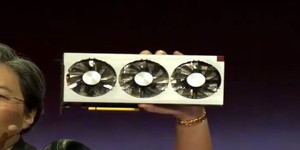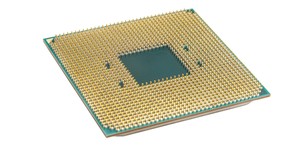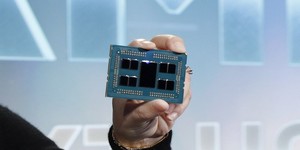AMD unveils 64-core Zen 2 CPU, first 7nm GPU
November 7, 2018 | 11:00
Companies: #amd #intel #taiwan-semiconductor

AMD has made good on its promise to reveal more information about its upcoming products, announcing that it will release its first graphics products based on a 7nm process node by the end of the year - but for data centre customers, not gamers, before you get too excited - while also unveiling the Zen 2 microarchitecture that will power its processors in 2019.
With AMD's rival Nvidia having largely cornered the high-end gaming GPU market, but with AMD promising to fight back, there were rumblings that AMD's press event late last night could bring with it the news of a new high-performance GPU - and it did, in a way: The company has announced the Radeon Instinct MI50 and MI60 accelerator boards, its first products to feature a graphics processor built on a 7nm process node, designed for accelerating machine intelligence and deep learning applications in the data centre.
'Legacy GPU architectures limit IT managers from effectively addressing the constantly evolving demands of processing and analysing huge datasets for modern cloud data centre workloads,' claims David Wang, senior vice president of engineering at AMD's Radeon Technologies Group. 'Combining world-class performance and a flexible architecture with a robust software platform and the industry's leading-edge ROCm open software ecosystem, the new AMD Radeon Instinct accelerators provide the critical components needed to solve the most difficult cloud computing challenges today and into the future.'
The boards, which come without video outputs, include 16GB or 32GB of High Bandwidth 2 (HBM2) error correcting code (ECC) memory onboard, while the ECC protection extends to the cache memories internal to the processors. The GPU, meanwhile, is claimed to be the world's fastest double-precision accelerator, with the MI60 incarnation offering 7.4 teraflops of peak 64-bit floating point performance and the MI50 up to 6.7 teraflops. Both, regardless of model, connect to the host on a PCI Express 4.0 (PCIe 4.0) bus, while an onboard Infinity Fabric link allows for up to four GPUs to be connected together in a 'hive ring configuration' with 200GB/s of peer-to-peer bandwidth. Two such rings can be fitted into a single server, the company has confirmed.
At the same event, AMD chief executive Dr. Lisa Su unveiled the company's next-generation CPU microarchitecture: Zen 2. Based, as with its latest GPU designs, on a 7nm process node - manufactured, as if the company has a choice, at Taiwan Semiconductor (TSMC) - the Zen 2 upgrade brings with it claims of an improved execution pipeline, an improved branch predictor, better instruction prefetching, a newly optimised instruction cache, larger operation cache, enhancements to floating point performance including a doubling of width to 256-bit, and new security features - including hardware protections against the Spectre family of speculative execution vulnerabilities.
AMD has confirmed that the 7nm Zen 2 family will launch with server-centric Epyc parts, showing off an engineering sample which uses a new multi-die configuration based on the concept of 'chiplets' linked with an improved version of Infinity Fabric to offer 64 physical cores and 128 logical threads on a single processor. Working under the codename Rome, the chip is claimed to offer considerable improvements in instructions-per-clock (IPC), the addition of PCI Express 4.0 connectivity, and a claimed doubling of performance-per-socket for traditional compute and quadrupling for floating-point operations compared to current-generation Epyc chips while retaining socket compatibility. While AMD claims the design handily beats Intel's Xeon Platinum 8180M at the C-Ray benchmark, though, the company has taken the unusual step of redacting full benchmark results until after the chip has launched.
While Rome is sampling with customers now, AMD has not yet proffered a timescale for consumer-centric Zen 2 implementations. It has also doubled-down on its previous roadmaps, claiming that development of its follow-up CPU architecture designs - Zen 3, based on an improved 7nm process, and the as-yet unknown node Zen 4 - is on track. AMD also used the event to announce a major win in the cloud computing market, with Amazon's Web Services division launching instances based on current-generation Epyc processors which are claimed to beat their Intel-based equivalents on performance-per-dollar.
More information on the announcements made during the event are available on the AMD Next Horizon page.

MSI MPG Velox 100R Chassis Review
October 14 2021 | 15:04








Want to comment? Please log in.